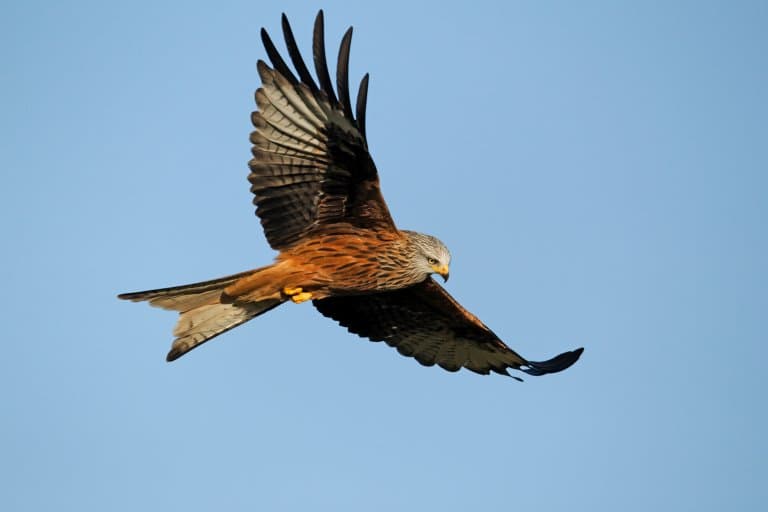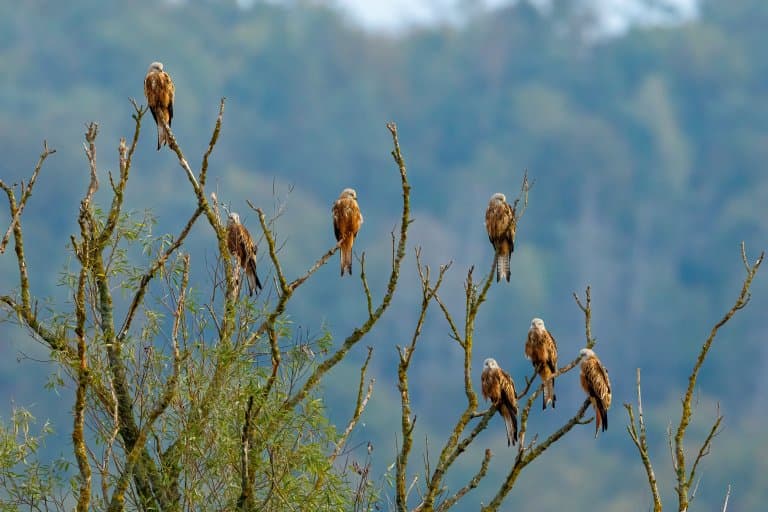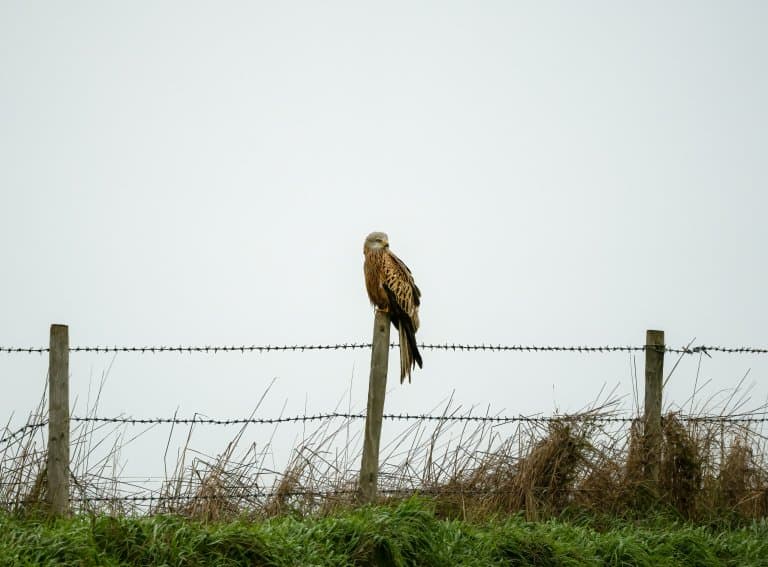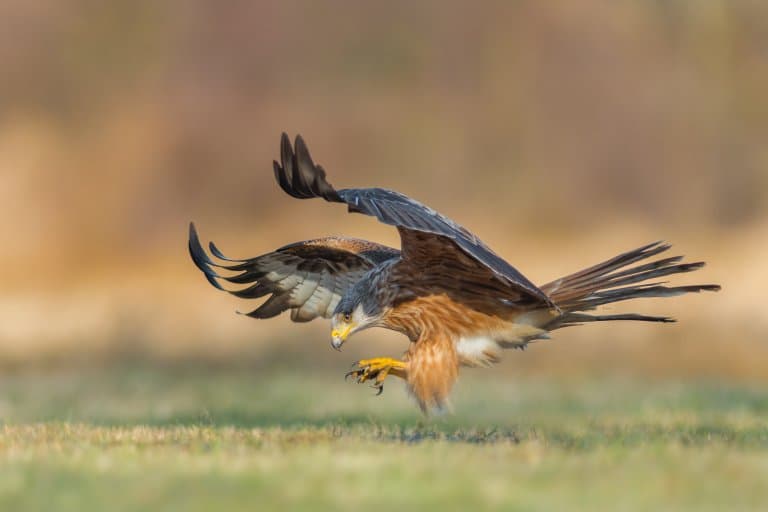Red Kite Profile
As is often the case, Britain has led the charge of habitat destruction, illegal poisoning, and all-round anti-environmental attitudes in Europe that resulted in the extinction of this bird to most of the Isles.
Thankfully, it’s back, and its iconic forked tail and enormous wingspan put a stamp on the red kite’s resilience.
The red kite is a medium-large bird of prey from the same deverse family that includes the little sparrowhawk, as well as the cinereous vulture.

Red Kite Facts Overview
| Habitat: | Forest, Shrubland, Grassland |
| Location: | Europe, The Middle East, Tunisia |
| Lifespan: | Up to 25 years |
| Size: | About 70cm tall with a 1.8m wingspan |
| Weight: | Up to 1,300g |
| Colour: | Rusty reddish brown |
| Diet: | Mostly carrion, some small birds and mammals |
| Predators: | Humans |
| Top Speed: | Not recorded |
| No. of Species: | 1 (2 subspecies) |
| Conservation Status: | Least Concern |
Red kites inhabit woodlands, valleys and rural areas mainly in Western Europe where 95% of breeding pairs reside. The 3 largest populations are in Germany, France and Spain which are thought to hold more than 75% of the global population.
The red kite can now be seen as a permanent fixture to much of Great Britain, as it is in many parts of the EU.
This large raptor is a fantastic opportunist and will largely diet on carrion, but has been continuously persecuted by poisons from farming, both deliberate and inadvertent.
But with recent reintroductions and other conservation programs proving a great success, it seems that everything’s coming up Milvus.
Interesting Red Kite Facts
1. They can be exceptionally social
For what is in most cases a sedentary bird, red kites can throw some epic parties.
Breeding colonies can often be found occupying pockets of woodland, with multiple breeding pairs and tens of individuals in the same space.
They’ll also roost with other species like ravens and crows, and many populations are cosmopolitan.

2. They have a little place in the South of France
A lot of the Northernmost populations of red kites are migratory, and make the most out of the continent.
During the Summer, they’ll enjoy the Fjords, and as the temperature drops, they’ll move down to the South of France, Iberia, and Spain to soak up the Mediterranean vibe.
Their variable and versatile range is in part a product of their ability to find food in almost every location.
3. They’re mostly scavengers
The Red Kite’s diet is one of the most varied and adaptable of any raptor. While they will hunt small mammals and birds, these huge raptors aren’t so keen on hunting as they are on an opportunistic feast on a dead animal.
They’re comfortable eating dead sheep in rural areas, or dead deer in forest environments, but they’re also quite happy to occupy urban settings, picking through kitchen waste and even stealing children’s sandwiches on occasion!
And this is one of the major reasons they’re so vulnerable to a lot of the threats they are currently facing. 1
4. Sarcastic slow flap
Red kites communicate a lot of their intentions via a series of visual displays. When they want to demonstrate territorialism, they have a range of options.
Sometimes, they’ll fly alongside a trespasser, like a military escort, guiding them out of their airspace.
Sometimes they’ll chase, or dive-bomb the intruder. In some cases, they’ll even grapple with their talons and initiate aerial cartwheeling.
But in cases where they want to be particularly sarcastic, they’ll perform a ritualised flight with exaggerated, slow flapping wings to really drive the point home. 2
5. They suffer from monocultures
The populations down in France are still in danger due to the shuffle-up of farming traditions. Grazing livestock is giving way to intensive farming of crops, and with that comes increased pesticides and the pollution they bring, as well as a decline in animal populations for kites to feed on.
In 2019, wind turbines killed 18 red kites in France, bringing this threat to the attention of conservationists. The increase in recycling and a corresponding decrease in waste dumps also removes a food source from the kite.
Many are also killed on the roads as a result of the ever-increasing traffic throughout Europe, though this isn’t a significant concern. 3
6. But they’re still poisoned by farmers
Farmers all over Europe are known to illegally poison the competition. Whether this competition is real or merely perceived, the poison is very much authentic, and in many contexts it’s indiscriminate.
The poisoning of predators and game animals is a problem for innumerable species, and for Red Kites, it is a grave danger. Poisons in Carrion, or from hunting infected rodents who have been toxified by pesticides still kiss hundreds of kites per year.
Between 430 and 1,800 individuals are estimated to have been illegally poisoned in Spain alone, showing the scope of the issue.

7. But they’re back!
Overall, the red kite population is increasing. Changes in land use and the whole poisoning fiasco had them listed as Near Threatened globally, and certainly wiped them out of most of Britain, but in most countries, the adaptability of this incredible bird has led to a strong comeback.
In other areas, direct conservation efforts have given them a little helping hand.
Global populations have increased by 30% over the last 3 generations, and they’re now listed as a species of Least Concern by the IUCN.
8. And their future looks bright
Further reintroductions are happening in Tuscany and Marche, in Northern Ireland and the Republic. Germany, France, Denmark and many other countries have species action plans in place, and Germany is assessing the wind farm issue.
So there are many eyes on the problem, and the Kite seems to be well looked after for now.

9. Pesticides are still a primary focus of their conservation
Its continued protection and the success of its conservation efforts do rely on certain trajectories to be addressed.
Pesticide regulation is not what it should be, and land-use changes that focus on perpetual growth instead of ecological harmony are inevitably doomed to fail at the price of hundreds of species.
In one recent study, around 30% of tested Kites were found to be poisoned, more than half of these as a product of secondary poisoning from rodenticides used on farms. All of this will slow their rate of recovery, and if these practices continue to increase could one day threaten the kite again, as it currently does so many other species.
More than 40 million birds have been flushed out of the UK over the last 50 years, so the recovery of Red Kite populations is a rare victory and an important pushback against the wave of extinction. 4
Red Kite Fact-File Summary
Scientific Classification
| Kingdom: | Animalia |
| Phylum: | Chordata |
| Class: | Aves |
| Order: | Accipitriformes |
| Family: | Accipitridae |
| Genus: | Milvus |
| Species: | Milvus Milvus |
Fact Sources & References
- (2018), “Fresh warning over red kite ‘attacks’ in Higginson Park, Marlow”, Bucks Free Press.
- Francois Mougeot (2011), “Breeding biology, behaviour, diet and conservation of the Red Kite (Milvus milvus), with particular emphasis on Mediterranean populations”, Diputación Foral de Vizcaya.
- I.M. Evans (2010), “Evaluating the success of translocating Red Kites Milvus milvus to the UK”, Taylor & Francis.
- Fieke M. Molenaar (2017), “Poisoning of reintroduced red kites (Milvus Milvus) in England”, European Journal of Wildlife Research.
